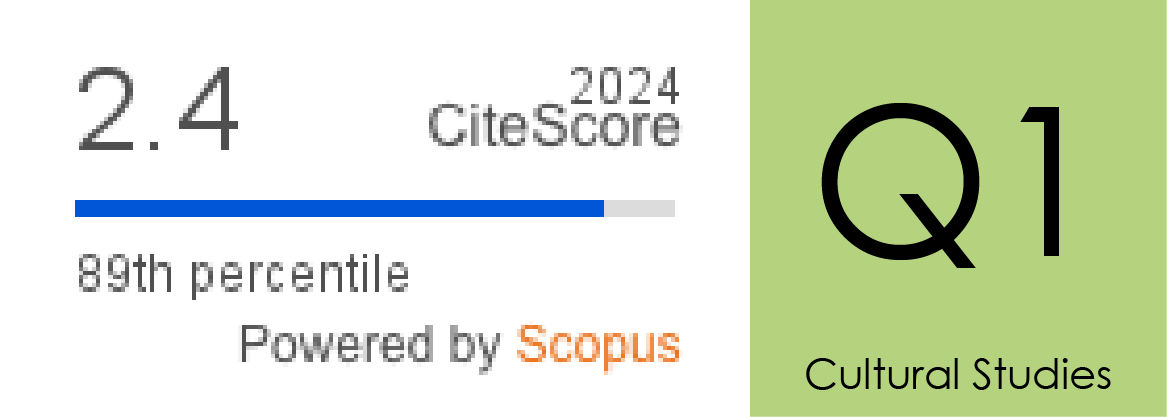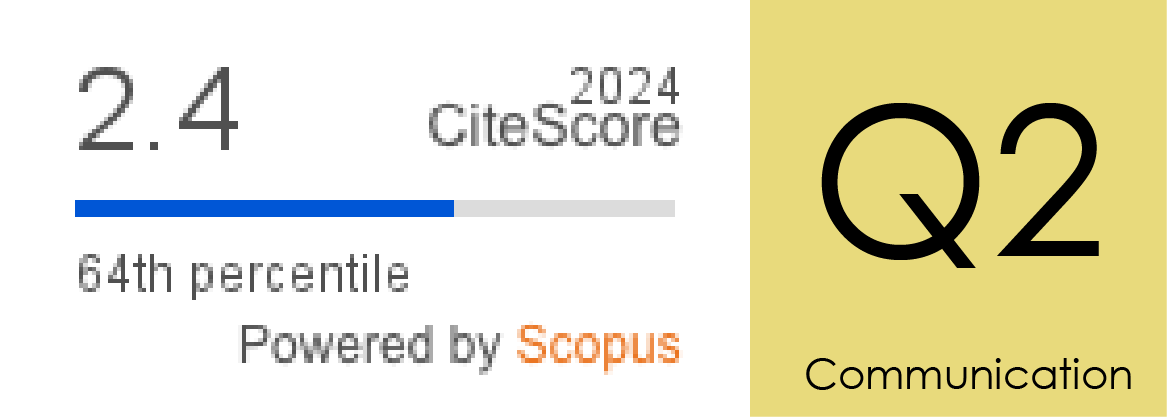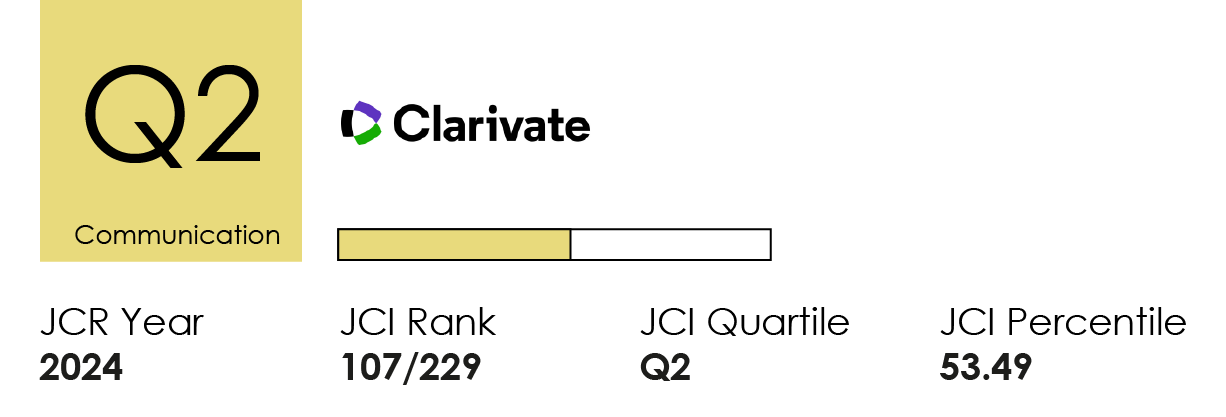Moda digital y sostenibilidad: impacto en el comportamiento del consumidor de la Generación Z en Croacia
DOI:
https://doi.org/10.14198/MEDCOM.28784Palabras clave:
Sostenibilidad, Moda digital, generación Z, comportamiento del consumidor, industria de la moda, responsabilidad social corporativaResumen
Propósito. Este estudio analiza el papel de la moda digital en la promoción de un consumo más sostenible dentro de la industria de la moda, con énfasis en la percepción de la Generación Z en Croacia. Metodología. Se realizó una encuesta cuantitativa en línea entre el 28 de junio y el 20 de agosto de 2024, obteniendo 83 respuestas de consumidores de la Generación Z, un segmento clave del mercado. Resultados y conclusiones. Los hallazgos revelan que la sostenibilidad en la moda es valorada por este grupo, influenciada por la conciencia ambiental, el compromiso digital y las iniciativas de responsabilidad social corporativa. Se identifica que la moda digital puede fomentar prácticas de compra más sostenibles al modificar la percepción del valor y la necesidad de productos físicos. Aportación original. La investigación contribuye al debate sobre la integración de la sostenibilidad en la moda digital, proporcionando información útil para marcas y académicos interesados en adaptar estrategias sostenibles y alinearse con las expectativas de la Generación Z.
Citas
Alkaissi H., & McFarlane I. S. (2023). Artificial Hallucinations in ChatGPT: Implications in Scientific Writing. Cureus, 15(2), e35179. https://doi.org/10.7759/cureus.35179
Allwood J. M., at. al. (2006). Well dressed? The present and future sustainability of clothing and textiles in the United Kingdom. University of Cambridge Institute for Manufacturing
Arrigo, E. (2021). Collaborative consumption in the fashion industry: A systematic literature review and conceptual framework. Journal of Cleaner Production, 325, e129261. https://doi.org/10.1016/j.jclepro.2021.129261
Ashoori, M., & Weisz, J. D. (2019). In ai we trust? Factors that influence trustworthiness of ai-infused decision-making processes. Cornell University. https://shre.ink/M4Bp
Berthem, F., & Mahrs, M. (2022). Sustainable Fashion A Generation Z Perspective. Švedska. https://shre.ink/M4Bk
Bertola, P., & Colombi, C. (2024). Can fashion be sustainable? Trajectories of change in organizational, products and processes, and socio-cultural contexts. Sustainability, 20(1). https://doi.org/10.1080/15487733.2024.2312682
Bourne, C. (2023) AI Hype: Public Relations and AI’s doomsday machine. Artificial Intelligence in Public Relations and Communications: cases, reflections, and predictions. Quadriga University of Applied Sciences. https://bit.ly/3EqPSxj
Božić, B., Kolić Stanić, M., & Jurišić, J. (2020). Corporate Social Responsibility in the Practice of Public Relations Professionals. In, Proceedings of the ENTRENOVA -ENTerprise REsearch InNOVAtion Conference (pp. 388-397). https://shre.ink/M4BI
Božić, B., Kolić Stanić, M., & Jurišić, J. (2021). The Relationship between Corporate Social Responsibility, Corporate Reputation, and Business Performance. Interdisciplinary Description of Complex Systems, 19(2), 281-294. https://doi.org/10.7906/indecs.19.2.7
Candeloro, D. (2020). Towards Sustainable Fashion: The Role of Artificial Intelligence --- H&M, Stella McCartney, Farfetch, Moosejaw: a multiple case study. ZoneModa Journal, 10(2), 91-105. https://doi.org/10.6092/issn.2611-0563/11837
Casciani, D., Chkanikova, O., & Pal, R. (2022). Exploring the nature of digital transformation in the fashion industry: opportunities for supply chains, business models, and sustainability-oriented innovations. Sustainability, 18(1), 773-795. https://doi.org/10.1080/15487733.2022.2125640
Centobelli, P; Abbate, S., Nadeem, S. P., & Garza-Reyes, J. A. (2022). Slowing the fast fashion industry: An all-round perspective. Current Opinion in Green and Sustainable Chemistry, 38, e100684. https://doi.org/10.1016/j.cogsc.2022.100684
Chu, Z., Gianvecchio, S., Wang, H., & Jajodia, S. (2010). Who is tweeting on Twitter: Human, bot or cyborg? In C. Gates (Ed.), Proceedings of the 26th Annual Computer Security Applications Conference, (pp. 21-30) https://doi.org/10.1145/1920261.1920265
Creangă, R. (2019). Fashion Sustainability in the Digital Realm. In, N. Kalbaska, T. Sádaba, F. Cominelli, & L. Cantoni (Ed.), Fashion Communication in the Digital Age. FACTUM 2019. Springer, Cham. https://doi.org/10.1007/978-3-030-15436-3_18
Colombi, C., & D’Itria, E. (2023). Fashion Digital Transformation: Innovating Business Models toward Circular Economy and Sustainability. Sustainability, 15, e4942. https://doi.org/10.3390/su15064942
Daukantien, V. (2023). Analysis of the sustainability aspects of fashion: A literature review. Textile Research Journal, 93(3–4), 991-1002. https://doi.org/10.1177/00405175221124971
Deng, Y., Shen, H., & Ji, X. (2024). Exploring Virtual Fashion Consumption through the Emotional Three-Level Theory: Reflections on Sustainable Consumer Behavior. Sustainability, 16, e5818. https://doi.org/10.3390/su16135818
Di Lodovico C., & Manzi, A. (2023). Navigating sustainability in the fashion industry: insights from entrepreneurial perspectives on collaborative approaches. Sustainability, 19(1). https://doi.org/10.1080/15487733.2023.2242707
Dobreva, T. (2023). Shedding light on the helper in the shadows. Artificial Intelligence in Public Relations and Communications: cases, reflections, and predictions. Quadriga University of Applied Sciences. https://bit.ly/4hqQrFK
Edwards, C., Edwards, A., Spence, P. R., & Shelton, A. K. (2014). Is that a bot running the social media feed? Testing the differences in perceptions of communication quality for a human agent and a bot agent on Twitter. Computers in Human Behavior, 33, 372-376. https://doi.org/10.1016/j.chb.2013.08.013
Ellen MacArthur Foundation (2017). A new textiles economy: Redesigning fashion’s future. https://www.ellenmacarthurfoundation.org/a-new-textiles-economy
European Environment Agency. (2022). Textiles and the environment: The role of design in Europe’s circular economy. https://bit.ly/3CDfWoe
Faria, A.P., & Cunha, J. (2023). Extended Reality (XR) in the Digital Fashion Landscape. In, N. Sabatini, T. Sádaba, A. Tosi, V. Neri, & Cantoni, L. (Ed.), Fashion Communication in the Digital Age. FACTUM 2023. Springer Proceedings in Business and Economics. Springer, Cham. https://doi.org/10.1007/978-3-031-38541-4_5
Grilec, A., Pandža Bajs, I., & Ruždjak, M. (2022). Društveno odgovorne aktivnosti i primjena koncepta održivosti u modnoj industrijI. Poslovna izvrsnost, 16(1), 73-89. https://doi.org/10.22598/pi-be/2022.16.1.73
Grunig, J. E. (2014). Ethics problems and theories in public relations. Communiquer, 11, 1-14.
Gunkel, D. J. (2017). Communication and artificial intelligence: New opportunities and challenges for communication research. Galáxia, 34. https://doi.org/10.7275/R5QJ7F7R
Gregory, A., & Virmani, S. (2020). The Effects of Artificial Intelligence on the Professions: A Literature Repository. https://bit.ly/4aRAmqb
Holy, M. (2021). Dokumentarni filmovi kao instrumenti promocije održive mode. Medijske studije, 12(24), 89-107. https://doi.org/10.20901/ms.12.24.6
Hong, Y., Al Mamun, A., Yang, Q., & Masukujjaman, M. (2024). Predicting sustainable fashion consumption intentions and practices. Scientific Raports, 14(1), e1706. https://doi.org/10.1038/s41598-024-52215-z
Huynh, P. (2022). Enabling Circular Business Models in the Fashion Industry: The Role of Digital Innovation. International Journal of Productivity and Performance Management, 71(3), 870-895. https://doi.org/10.1108/IJPPM-12- 2020-0683
Iannilli, V. M., & Spagnoli, A. (2024). Conscious Fashion Culture: Rethinking consumption in contemporary fashion. Fashion Highlight, (3), 8-15. https://doi.org/10.36253/fh-2875
Jakesch, M., French, M., Ma, X., Hancock, J. T., & Naaman, M. (2019). AI-Mediated Communication: How the Perception that Profile Text was Written by AI Affects Trustworthiness. In, S. Brewster, G. Fitzpatrick (Ed.), Proceedings of the 2019 CHI Conference on Human Factors in Computing Systems - CHI ’19. (pp. 1-13). Association for Computing Machinery. https://doi.org/10.1145/3290605.3300469
Jurišić, R. I., Dabo, K., & Kolić Stanić, M. (2024). The Myth of Influencers: Does generation Z really trust them? Interdisciplinary description of complex systems, 22(4), 378-400. https://doi.org/10.7906/indecs.22.4.2
Joy, A., & Peña, C. (2017). Sustainability and the Fashion Industry: Conceptualizing Nature and Traceability. Sustainability in Fashion, 31-54. https://doi.org/10.1007/978-3-319-51253-2_3
Kalambura, S., Pedro, S., & Paixão, S. (2020). Fast Fashion – Sustainability and Climate Change. Comparative Study in Croatia and Portugal. Socijalna ekologija, 29(2), 269-291. https://doi.org/10.17234/SocEkol.29.2.6
Kang, J., & Kim S.-H. (2013). What are consumers afraid of? Understanding perceived risk toward the consumption of environmentally sustainable apparel. Family & consumer sciences research journal, 41(3), 267-283. https://doi.org/10.1111/fcsr.12013
Kim, T., & Song, H. (2020). How should intelligent agents apologize to restore trust?: The interaction effect between anthropomorphism and apology attribution on trust repair. PsyArXiv, 61, e101595. https://doi.org/10.31234/osf.io/234f5
Kolić Stanić, M., & Barišić, A. F. (2019). Social Responsibility and Loyalty in Public Relations Codes. Business Systems Research, 10(2), 151-162. https://doi.org/10.2478/bsrj-2019-024
Kolić Stanić, M. (2020). How the theory of information and journalism ethics contributes to the ethics of public relations: six principles from the dialogue between codes of ethics and Luka Brajnović’s legacy. Church, Communication and Culture, 5(1), 36-62. https://doi.org/10.1080/23753234.2020.1713013
Kolić Stanić, M. (2019). Transparency in Public Relations: Evidence from Associations’ Ethics Codes. Interdisciplinary Description of Complex Systems, 17(2-B), 417-429. https://doi.org/10.7906/indecs.17.2.15
Kolić Stanić, M., & Stanić, B. (2024). How to Ethically Use Artificial Intelligence in The Institutional Communication of the Catholic Church? Roczniki Nauk Społecznych, 52(3), 1-15. https://doi.org/10.18290/rns2024.0021
Kolić Stanić, M., & Pejić Bach, M. (2023). Što čitaju algoritmi? Etička pitanja u odnosima s javnošću. In: M. Togonal, J. Ćurković Nimac (Ed.), Čitatelj i čitanje u digitalno doba. (pp. 179-189). Hrvatsko katoličko sveučilište. https://shre.ink/M4p0
Kyrlitsias, C., & Michael-Grigoriou, D. (2022). Social interaction with agents and avatars in Immersive virtual environments: A Survey. Frontiers in Virtual Reality, 2, e786665. https://doi.org/10.3389/frvir.2021.786665
Lim, S., & Reeves, B. (2010). Computer agents versus avatars: Responses to interactive game characters controlled by a computer or other player. International Journal of Human–Computer Studies, 68(1-2), 57-68. https://doi.org/10.1080/03637750903074685
Markuz, A., Plećaš, M., & Ban, D. (2022). Koncept održive mode generacije Z. Acta Economica Et Turistica, 8(2), 169-193. https://doi.org/10.46672/aet.8.2.2
McCartney, S. (2023). Measuring our impact. Stellamccaartney.com. https://www.stellamccartney.com/experience/it/sustainability/themes/measuring-our-impact/.
McQuillan, H. (2020). Digital 3D design as a tool for augmenting zero-waste fashion design practice. International Journal of Fashion Design, Technology and Education, 13(1), 89–100. https://doi.org/10.1080/17543266.2020.1737248
Mesjar, L.; Cross, K.; Jiang, Y.; and Steed, J. (2023). The Intersection of Fashion, Immersive Technology, and Sustainability: A Literature Review. Sustainability, 15, e3761. https://doi.org/10.3390/su15043761
Miller, T. (2019). Explanation in artificial intelligence: Insights from the social sciences. Artificial Intelligence, 267, 1-38. https://doiorg.usd.idm.oclc.org/10.1016/j.artint.2018.07.007
Moody, W., Langdon, P. M., & Karam, M. (2018). Enhancing the Fashion and Textile Design Process and Wearer Experiences. In, P. Langdon, J. Lazar, A. Heylighen, & H. Dong (Ed.), Breaking Down Barriers. Springer, Cham. https://doi.org/10.1007/978-3-319-75028-6_5
Mou, Y., & Xu, K. (2017). The media inequality: Comparing the initial human-human and human-AI social interactions. Computers in Human Behavior, 72, 432-440. https://doi.org/10.1016/j.chb.2017.02.067
Nobile, T. H., Kalbaska, N., de Oliveira, R. A., & Cantoni, L. (2021). Digital Fashion Competences: A Longitudinal Study. In, T. Sádaba, N. Kalbaska, F. Cominelli, L. Cantoni, & M. Torregrosa Puig (Ed.), Fashion Communication. FACTUM 2021. Springer, Cham. https://doi.org/10.1007/978-3-030-81321-5_2
Noris, A., Nobile, T. H., Kalbaska, N., & Cantoni, L. (2020). Digital Fashion: A systematic literature review. A perspective on marketing and communication. Journal of Global Fashion Marketing, 12(1), 32-46. https://doi.org/10.1080/20932685.2020.1835522
Park, H., & Lim, R. E. (2023). Fashion and the metaverse: Clarifying the domain and establishing a research agenda. Journal of Retailing and Consumer Services, 74. https://doi.org/10.1016/j.jretconser.2023.103413
Periyasamy, A. P., & Periyasami, S. (2023). Rise of digital fashion and metaverse: influence on sustainability. DESD, 1, 16. https://doi.org/10.1007/s44265-023-00016-z
Polak, M., Kolić Stanić, M., and Togonal, M. (2022). Artificial Intelligence in Communication with Music Fans: An Example from South Korea. ENTRENOVA -ENTerprise REsearch InNOVAtion, 8(1), 48-63, https://doi.org/10.54820/entrenova-2022-0006
Ray, S., & Nayak, L. (2023). Marketing Sustainable Fashion: Trends and Future Directions. Sustainability, 15, e6202. https://doi.org/10.3390/su15076202
Rezo, A. Z., Kolić Stanić, and M., Togonal, M. (2021). Public Relations Principles for the Digital Communication in a Local Crisis. ENTRENOVA - ENTerprise REsearch InNOVAtion, 7(1), 52-65. https://doi.org/10.54820/EUXG7226
Roberts-Islam, B. (2020). How Digital Fashion Could Replace Fast Fashion, and the Startup Paving the Way. Forbes
Rosato, L., & Calleo, A. (2023). Digital Fashion Technologies & Practices: design driven sustainable transition in fashion industry. DIID, 1, 162-169. https://doi.org/10.30682/diiddsi23t1n
Ruiz Viñals, C., Gil Ibáñez, M., & Del Olmo Arriaga, J. L. (2024). Metaverse and Fashion: An Analysis of Consumer Online Interest. Future Internet 2024, 16, e199. https://doi.org/10.3390/fi16060199
Sangwon L., Seungahn N., Deborah S. C., & Junghwan K. (2020) Predicting AI news credibility: Communicative or social capital or both? Communication Studies, 71(3), 428-447. https://doi.org/10.1080/10510974.2020.1779769
Särmäkari, N. (2021). “Digital fashion” on its way from niche to the new norm. L. Aliabieva (Ed.) 117-134. http://bit.ly/3Forixv
Statista (2023). Número de Usuarios del Metaverso a Nivel Mundial Entre 2022 y 2030. Statista.
Temperino, E. (2023). The Perks of Being Digital. Nikeland: A Case Study. In, N. Sabatini, T. Sádaba, A. Tosi, V. Neri, & L. Cantoni (Ed.), Fashion Communication in the Digital Age. Springer Proceedings in Business and Economics. Springer, Cham. https://doi.org/10.1007/978-3-031-38541-4_9
von der Assen, L. (2023). Digitalization as a Provider of Sustainability? The Role and Acceptance of Digital Technologies in Fashion Stores. Sustainability, 15, e4621. https://doi.org/10.3390/su15054621
Vassalo, A. L., Marques, C. G., Simões, J. T., Fernandes, M. M., & Domingos, S. (2024). Sustainability in the Fashion Industry in Relation to Consumption in a Digital Age. Sustainability, 16, e5303. https://doi.org/10.3390/su16135303
Wachholz, L. A., & Pinheiro, E. (2017). Sustainable Fashion Strategies: A Study Applied to the Development of Clothing Products. MIX Sustentável, 3(4), 157-172. https://doi.org/10.29183/2447-3073.MIX2017.v3.n4.157-172
Winterhalter, C. (2023). Metaverse and Its Communication. The Future is Here. True or False? In, N. Sabatini, T. Sádaba, A. Tosi, V. Neri, & L. Cantoni (Ed.), Fashion Communication in the Digital Age. Springer Proceedings in Business and Economics. Springer, Cham. https://doi.org/10.1007/978-3-031-38541-4_4
Zytnik, M., & Lequick, M. (2023). Getting colleagues comfortable with AI: A human-centered approach to technology in organizations. In, A. Addi (Ed.), Artificial Intelligence in Public Relations and Communications: cases, reflections, and predictions, (pp.73-84). Quadriga University of Applied Sciences. https://shre.ink/M4pV
Descargas
Estadísticas
Publicado
Cómo citar
Número
Sección
Licencia
Derechos de autor 2018 Hana Lučić, Matilda Kolić-Stanić, Kresimir Dabo

Esta obra está bajo una licencia internacional Creative Commons Atribución 4.0.
Los autores y autoras que publican en esta revista están de acuerdo con los siguientes términos:
1 Derechos de autor. Los autores y autoras conservan sus derechos de autor, aunque ceden a la revista de forma no exclusiva los derechos de explotación (reproducción, distribución, comunicación pública y transformación) y garantizan a esta el derecho de primera publicación de su trabajo, el cual estará simultáneamente sujeto a la licencia indicada en punto 2. Los autores pueden establecer otros acuerdos adicionales para la distribución no exclusiva de la versión de la obra publicada en la revista, siempre que exista un reconocimiento de su publicación inicial en esta revista.
© Los autores.
2 Licencia. Los trabajos se publican en la revista sujetos a la licencia de Reconocimiento 4.0 Internacional de Creative Commons (CC BY 4.0); los términos se pueden consultar en https://creativecommons.org/licenses/by/4.0/
Esta licencia permite a terceros compartir (copiar y redistribuir el material en cualquier medio o formato) y adaptar (remezclar, transformar y crear a partir del material para cualquier finalidad, incluso comercial), siempre que se reconozca la autoría y la primera publicación en esta revista (Revista Mediterránea de Comunicación (RMC) / Mediterranean Journal of Communication (MJC), Universidad de Alicante, DOI de la obra), se proporcione un enlace a la licencia y se indique si se han realizado cambios en la obra.
3 Política de autoarchivo. Se recomienda a los autores que difundan sus trabajos a través de Internet para favorecer una circulación y difusión más rápidas y, con ello, un posible aumento en la citación y alcance entre la comunidad científica y académica, en las siguientes condiciones:
No se permite a los autores depositar en un repositorio institucional o temático, página web propia, etc., las versiones preprint (versión antes de ser evaluada) o postprint (versión evaluada y aceptada para su publicación) de sus trabajos antes de su publicación, pero sí el artículo final publicado (versión del editor).













